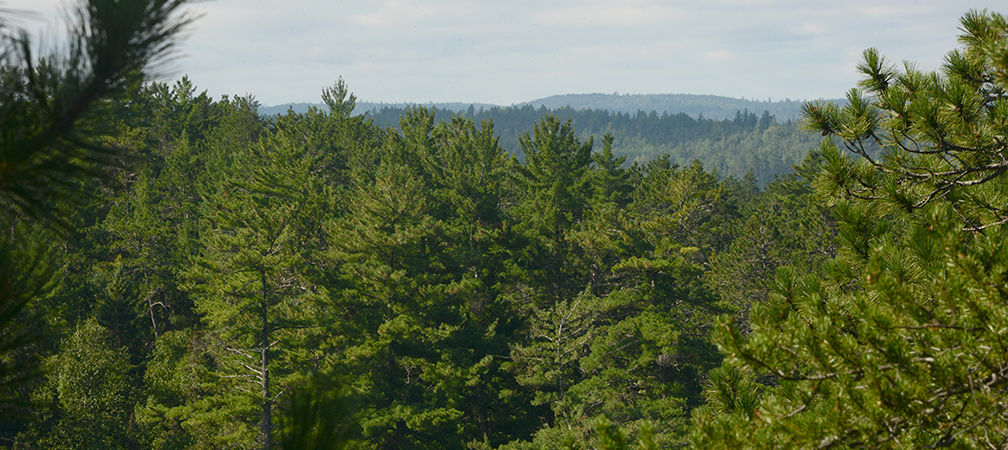Ontario Nature Blog
Receive email alerts about breaking conservation
and environmental news.
© Lora Denis
Catchacoma Lake © David Allan Barker CC BY-NC-SA 2.0
On November 2nd at the United Nations Climate Change Conference (known as COP26), over 100 world leaders, including Prime Minister Justin Trudeau, pledged to end and reverse deforestation by 2030. Nature-based climate solutions, such as protecting and restoring forests, are premised on working with nature to meet our climate and biodiversity targets.
Old growth forests are an example of a natural climate solution due to their ability to store large amounts of carbon. They are characterized by the presence of trees over 150 years old, high species diversity and lack of human disturbance. Yet, today, in Ontario and worldwide, many old-growth forests are unprotected and becoming increasingly rare.
The commitment to stop deforestation by 2030 is welcomed. However, for the preservation of our old-growth forests, it is critical that we act now to protect these vital ecosystems rather than delay action for another nine years.
“The older the tree, the more quickly it grows… if we want to use forests to combat climate change, we must allow them to grow old.“
– Peter Wohlleben, author of The Hidden Life of Trees

The Catchacoma old-growth Forest, located in northern Peterborough County, Ontario, is considered the largest tract of old-growth eastern hemlock in Canada. At least 226 species have been identified here, including species at risk, such as the Algonquin wolf, Blanding’s turtle, and the monarch butterfly. The forest is currently open to logging.
Near Sudbury, Ontario, Wolf Lake Forest Reserve is another forest home to 300-year-old trees. It is considered the largest intact old-growth red pine forest in North America. The forest is currently protected from logging but open to mining and mineral exploration.


When we protect old-growth forests, we all benefit.
“In some Native languages the term for plants translates to ‘those who take care of us.‘”
– Robin Wall Kimmerer, author of Braiding Sweetgrass: Indigenous Wisdom, Scientific Knowledge, and the Teachings of Plants and member of the Citizen Potawatomi Nation
Protecting old-growth forests is a nature-based climate solution with numerous benefits. According to a study by Nature United, improving the management of Canada’s forests, which involves protecting old-growth forests, can mitigate 7.9 megatonnes of greenhouse gases per year in 2030. To put this into context, 7.9 megatonnes is equivalent to powering two million Canadian homes for an entire year. Additionally, the protection of Ontario’s old-growth forests provides threatened species like the cerulean warbler and the Algonquin wolf a chance for survival.
We must prioritize the conservation and protection of Ontario’s old-growth forests. Climate action cannot wait.
This project was funded by the Career-Launcher Internships program with the financial support of the Government of Canada through the federal Department of Environment and Climate Change, and an Anonymous Donor.

Gananoque Lake Nature Reserve © Smera Sukumar
We live in Port Colbourne and the city is allowing 100 year old trees to be cut down due to maintenance of side walks etc. who can I contact to help have this stopped.
Mike
Likely all who read Ontario Nature’s posts agree about the need for protecting the Earth and Her forests. What is needed are suggestions, even leadership, on a way forward from our current morass. For instance, there’s a provincial election next year (an NDP candidate has already been to my door); are we organizing for it? Are we going to do more than just send out surveys? This government is wrecking conservation in Ontario. Are there any Ontario Nature plans to oppose it, or support others? If not, why not?
Hello Ian,
As an environmental watchdog, we hold all levels of government to account when they undermine protections for wild species and wild spaces. We are – and as a registered charity have to be – non-partisan. But we’ll call for people to vote for nature in the upcoming election as we always do. We work with coalitions such as Green Priorities and Yours to Protect to put environmental issues front and centre, including with the upcoming election. Please stay tuned for more outreach about the environmental platforms of all parties and what we see as the key election issues.
– The Team at Ontario Nature
I understand that deforestation is partially responsible for the washouts in BC this month. Trees absorb water and help keep balance in heavy rained areas. Ontario is not in quite the same space, but the concern is still with me. We must prevent deforestation.
Linda Sloan
We need to conserve our old growth forests.they’re biodiversity not only helps maintain indigenous wildlife,it also keeps moisture in the soil to prevent flooding and it retains carbon and the network of roots promotes growth of many important plants.
Yes, protection by 2030 means nothing will be left to protect. Natural old growth forests are so much more effective in sequestering carbon than man-made forests. They have their own culture to support each other. We need these protections NOW!
It is vital to save our old growth
forests
Thanks for your blog, Jenna. This is a topic that deserves a lot more attention. Many still insist that managed forests are actually better at sequestering carbon than old growth forests are, and this belief is used as justification for cutting down old growth forests. Here’s just one of MANY articles making that claim: https://psmag.com/environment/young-trees-suck-up-more-carbon-than-old-ones
Our greatest resource is nature – the flora and fauna ecosystems sustain us mentally and physically, it’s beyond time that we conserve and preserve that which without we will not survive as well. Destroying everything in the name of profit is self-destructive!
Old Growth Forests have survived this long so that we and all its creatures will survive.
Yes old growth forests must be protected
Surely we can get the lumber we need without destroying the old growth forests we have left. Lets protect these pockets of invaluable ecosystems from unnecessary destruction.
Reply